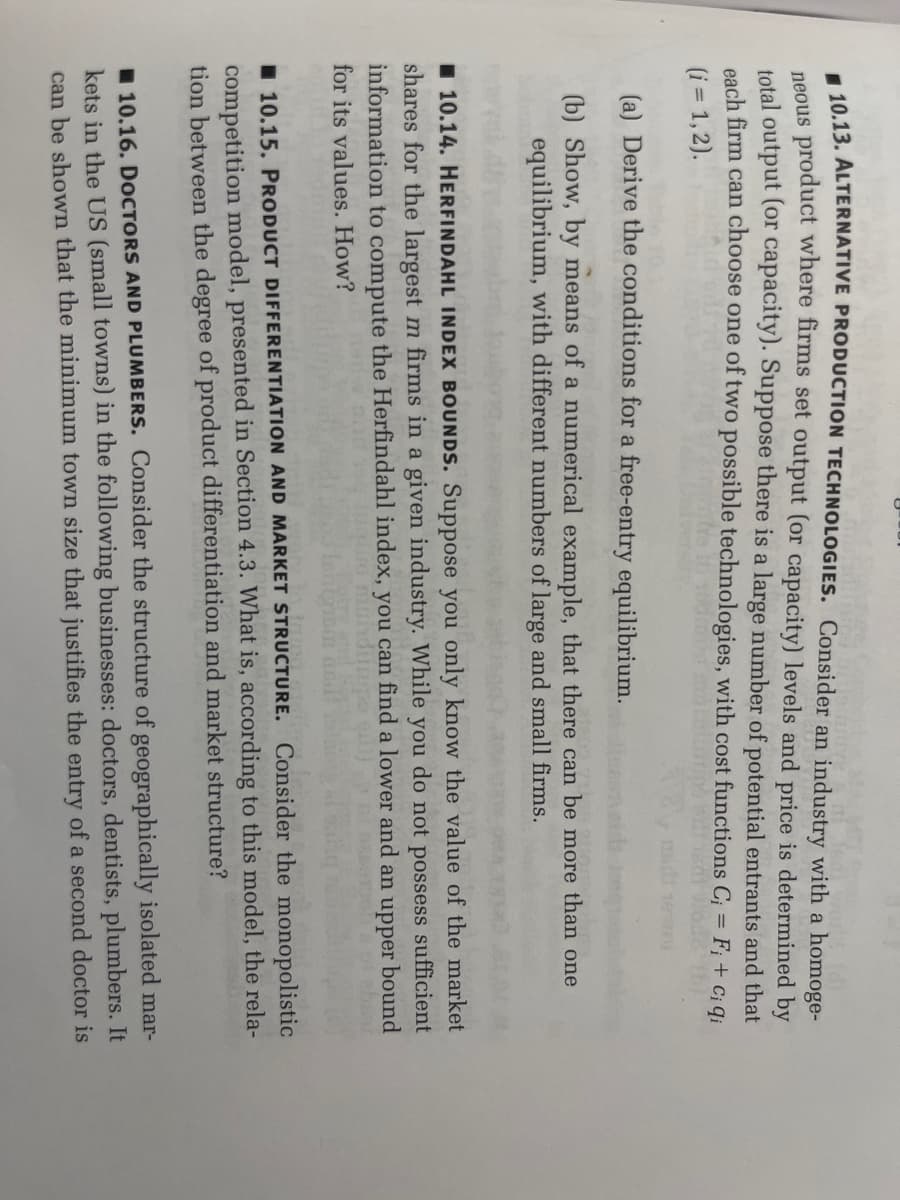neous 10.13. ALTERNATIVE PRODUCTION TECHNOLOGIES. Consider an industry with a product where firms set output (or capacity) levels and price is deter total output (or capacity). Suppose there is a large number of potential entrant each firm can choose one of two possible (i = 1,2). technologies, with cost functions C₁ = (a) Derive the conditions for a free-entry equilibrium. (b) Show, by means of a numerical example, that there can be more tha equilibrium, with different numbers of large and small firms.
neous 10.13. ALTERNATIVE PRODUCTION TECHNOLOGIES. Consider an industry with a product where firms set output (or capacity) levels and price is deter total output (or capacity). Suppose there is a large number of potential entrant each firm can choose one of two possible (i = 1,2). technologies, with cost functions C₁ = (a) Derive the conditions for a free-entry equilibrium. (b) Show, by means of a numerical example, that there can be more tha equilibrium, with different numbers of large and small firms.
Managerial Economics: Applications, Strategies and Tactics (MindTap Course List)
14th Edition
ISBN:9781305506381
Author:James R. McGuigan, R. Charles Moyer, Frederick H.deB. Harris
Publisher:James R. McGuigan, R. Charles Moyer, Frederick H.deB. Harris
Chapter16: Government Regulation
Section: Chapter Questions
Problem 6E
Related questions
Question
10.13

Transcribed Image Text:neous
10.13. ALTERNATIVE PRODUCTION TECHNOLOGIES. Consider an industry with a homoge-
rod (d)
product where firms set output (or capacity) levels and price is determined by
total output (or capacity). Suppose there is a large number of potential entrants and that
each firm can choose one of two possible technologies, with cost functions C₁ = F; + C¡ qi
(i = 1,2).
Godmod
(a) Derive the conditions for a free-entry equilibrium.
(b) Show, by means of a numerical example, that there can be more than one
equilibrium, with different numbers of large and small firms.
10.14. HERFINDAHL INDEX BOUNDS. Suppose you only know the value of the market
shares for the largest m firms in a given industry. While you do not possess sufficient
information to compute the Herfindahl index, you can find a lower and an upper bound
for its values. How?
10.15. PRODUCT DIFFERENTIATION AND MARKET STRUCTURE. Consider the monopolistic
competition model, presented in Section 4.3. What is, according to this model, the rela-
tion between the degree of product differentiation and market structure?
10.16. DOCTORS AND PLUMBERS. Consider the structure of geographically isolated mar-
kets in the US (small towns) in the following businesses: doctors, dentists, plumbers. It
can be shown that the minimum town size that justifies the entry of a second doctor is
Expert Solution
This question has been solved!
Explore an expertly crafted, step-by-step solution for a thorough understanding of key concepts.
Step by step
Solved in 3 steps with 2 images

Knowledge Booster
Learn more about
Need a deep-dive on the concept behind this application? Look no further. Learn more about this topic, economics and related others by exploring similar questions and additional content below.Recommended textbooks for you

Managerial Economics: Applications, Strategies an…
Economics
ISBN:
9781305506381
Author:
James R. McGuigan, R. Charles Moyer, Frederick H.deB. Harris
Publisher:
Cengage Learning

Managerial Economics: Applications, Strategies an…
Economics
ISBN:
9781305506381
Author:
James R. McGuigan, R. Charles Moyer, Frederick H.deB. Harris
Publisher:
Cengage Learning